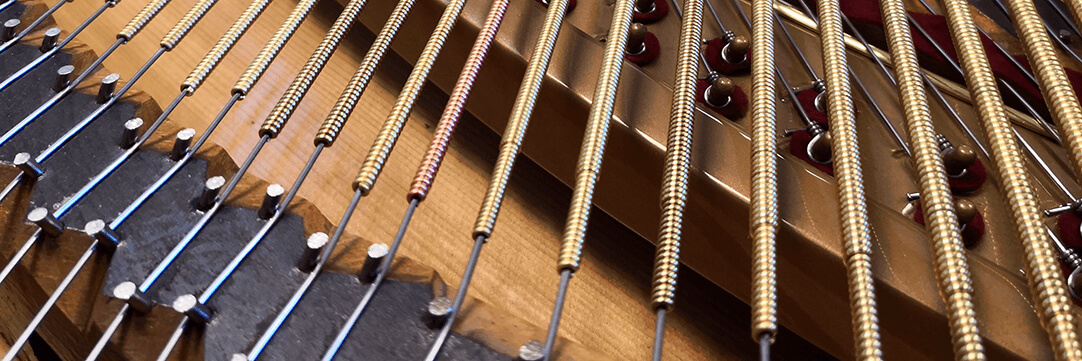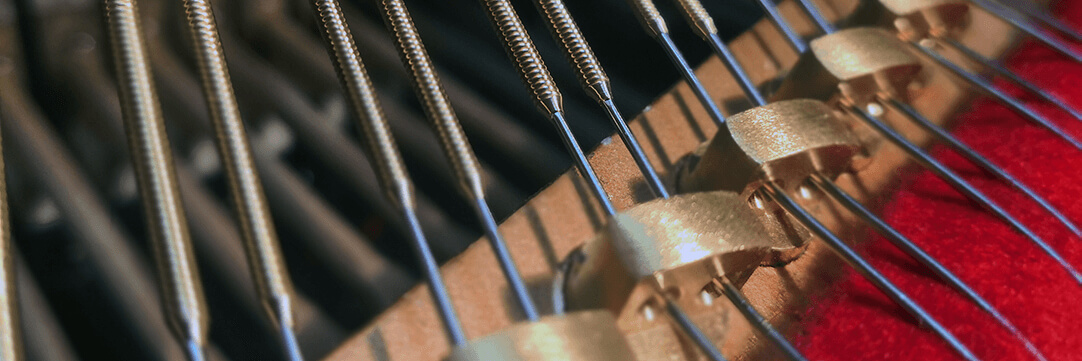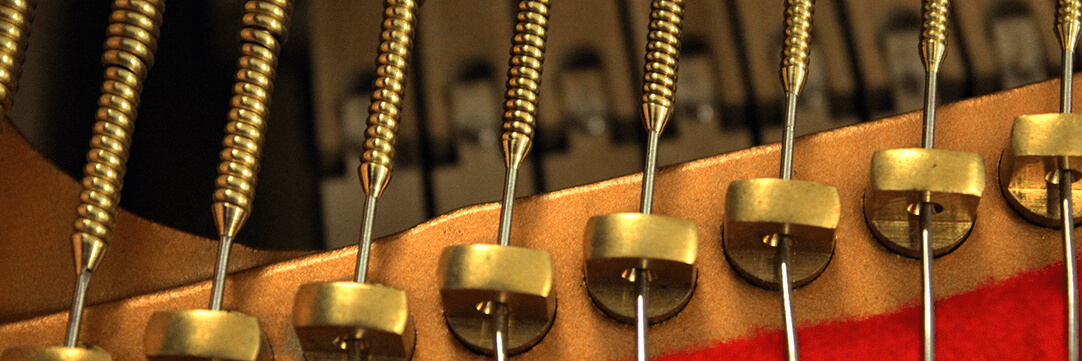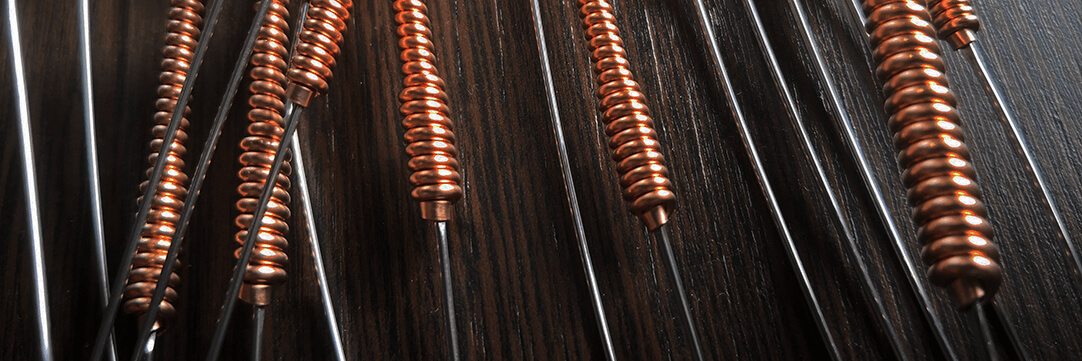Quality Strings designs and fabricates bespoke bass strings for upright and grand pianos
Additionally the plain wire unisons can be improved by rescaling
Our proprietary software brings the entire scale into balance, producing a homogeneous sound
Please find our Frequently Askes Questions below
Why do you only supply to piano technicians?
To ensure the high quality of our strings, accurate data while ordering and proper installation is very important. For these reasons we only supply to trained specialists
How do I recognize Inox (or stainless steel) wire?
Inox has a more silvery sheen. When you flatten the wire with a hammer, cracks will appear in the longitudinal direction. This does not happen with Röslau
What is the difference between Röslau and Inox wire?
Inox (also known as stainless steel) is a different, more brittle, alloy than Röslau. The sound of strings manufactured with Inox is generally brighter. Inox was widely used in the past but partly because Inox strings break more easilly, Röslau is the industry standard for quite some time now
Do you have Pure Sound wire?
Pure sound is very similar to Inox or stainless steel wire which is common in older instruments. If required, we can supply strings with Inox core material
Do brass wound strings sound different from copper wound strings?
Brass, an alloy of copper and zinc, is a harder material than copper and therefore produces a brighter tone. Brass was quite common in the past, often used in combination with an Inox core. If required we can also fabricate strings with brass windings
Why do you not offer hexagonal wire?
Hexagonal wire simply does not meet our high standards. To ensure the quality we are known for, we only supply strings with a round core
Are your strings made by hand?
We only produce bespoke strings, custom scaled and manufactured for each individual instrument. Our high standards can not be met with standardized production methods. Hence all our strings are handmade
Complete set of bass strings
How much does a complete set of bass strings cost?
The price of your new set of bass strings is composed of several factors including:
* The number of strings
* The length of the strings
* Finishes if any
* Materials used
Therefore we do not have fixed prices. A complete set of bass strings, custom scaled and manufactured, starts at € 250,- ex VAT
Why do I have to make a pattern?
Even instruments of the same brand and type can show significant differences, particularly concerning the placement of the bridge. To achieve truly bespoke bass strings a blueprint of the instrument (a pattern) is indispensable
What is the delivery time for a complete set of bass strings?
We aim to ship your new set of bass strings within 2 weeks after receiving your order
I need a set of bass strings for instrument X, do you have these in stock?
Only custom scaled and fabricated strings using a pattern for each individual instrument meet our high standards, these can not be met using standardized production methods. Hence wo do not have any strings in stock
Do you re-scale a complete set of bass strings?
Certainly, every set of bass strings is custom scaled based on the pattern of the instrument
What software do you use for scale design?
We use our proprietary software for scaling each set of bass strings, developed through 25 years of expertise
What makes your software different?
Our proprietary software will bring the scale into much better balance by combining a smooth ADSR progression with balanced clarity. The result is a homogeneous sound.
Go to Scale Design
Does the software used determine the end result?
No matter how good our program is, software alone will never be sufficient for achieving optimal results. For the correct interpretation of the calculated variables and a good translation into the real world, experience will allways be essential
What will be adjusted when you rescale a set of bass strings?
During scale design we reservedly adjust any factors which contribute to an instruments character. Usually good sound improvements can be achieved by altering the core to total diameter ratio, but only if production is done correctly. There are however many other factors which we affect to a greater or lesser extent depending on the instrument. Additionally the plain wire unisons can be improved by rescaling
Is measuring the speaking lengths really necessary?
We can account for any pattern deviations using the speaking length measurements taken in the instrument. Without these measurements we have to assume the pattern is accurate and you accept the risks of any deviations
What do the different eye types and finishes look like?
The dimensions of the new strings are different from the old strings
There may be differences in the dimensions of the strings due to rescaling. These are necessary in order to improve the sound
Why do I need to measure the diameters with a micrometer?
In order to get an accurate measurement ( 0,01mm ), a micrometer is indispensable
Can I use a caliper to measure the diameters?
No, a caliper has an accuracy of 0.1 mm where an accuracy of 0.01 mm is needed . A caliper is simply not accurate enough
Do you fabricate strings according to a scale provided by me?
We largely owe our reputation to the sound of our in house designed scales. For that reason, we normally do not fabricate strings which we have not scaled ourselves
How much does a single string cost?
The price of your string depends on several factors, including:
* The length
* The total diameter
* Materials used
* Finishes if any
We therefore do not have fixed prices. After you have entered your string in our configurator, the price will be calculated for you
How do I measure a string?
Here will be a link to a video showing how to measure a string
Should I consider the elongation when specifying the sizes?
No need, we will do that for you. Do let us know whether the string is measured under tension or not and what key number it concerns
Why will you not give any warranty when I do not provide a key number?
Without a key number we can not calculate the tension on the string, hence it can not be determined whether a string will break or not
How do I determine the key number?
Subcontra A is always key number 1 (even when, in rare cases, it is not the first key on the keyboard ). See picture below
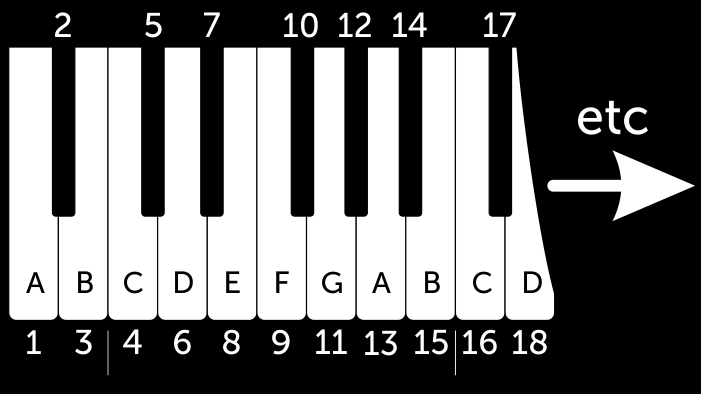
I need a string with key number x for instrument y , do you have it in stock ?
We custom make each string to ensure the highest quality, therefore we have no strings in stock
How do I recognize Inox (or stainless steel) wire?
Inox has a more silvery sheen . When you flatten the wire with a hammer, cracks will appear in the longitudinal direction. This does not happen with Röslau
Why should I replace all the strings in a chord?
There will always be tonal differences between old and new strings, even when they have the same dimensions. To prevent this, simply replace the entire chord
The dimensions of the new string differ from what I have ordered
The dimensions of the new string can sometimes differ to ensure the string will not break
Why do not you offer hexagonal core wire?
Hexagonal core wire simply does not meet our high standards. To ensure the quality we are known for, we only supply strings with a round core
I have a string with hexagonal core wire , what measurement should I enter for the core diameter?
In case of hexagonal wire you measure the thinnest size for the core diameter:
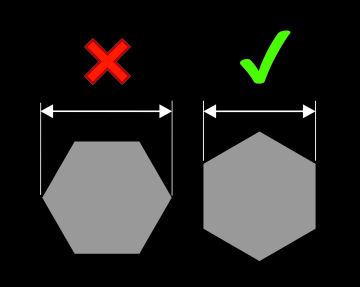
Why do I need to measure the diameters with a micrometer?
In order to get an accurate measurement ( 0,01mm ), a micrometer is indispensable
Can I use a caliper to measure the diameters?
No, a caliper has an accuracy of 0.1 mm where an accuracy of 0.01 mm is needed. A caliper is simply not accurate enough
Do you rescale individual strings?
Rescaling individual strings to achieve sound improvement is meaningless since we have no influence on the surrounding strings. One very good sounding unison amongst a whole lot of less-sounding ones is undesirable. However, we do calculate whether the string is at risk of breaking in order to then provide a warranty (we can only do this if the key number is provided)
Do finishes influence the sound?
The various finishes have a negligible effect on the sound
What do the different eye types and finishes look like?
Why should I twist the strings during installation?
By twisting the string in the direction of the windings during the installation they will tighten up and improve sound
Which way do I twist the string during installation?
In case of an English eye - twist clockwise by 180 to 360 degrees
In case of a German or double German eye - twist anticlockwise by 180 to 360 degrees
